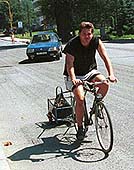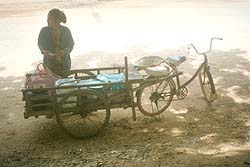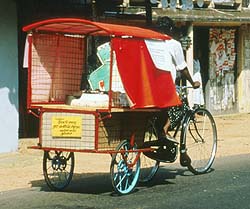|
|
Adoption
is not automatic
|
| Project
initiatives must encompass participatory methods to clearly establish
the likely benefits, costs, usage patterns, gender issues and the
technical, social and economic constraints to transport technologies.
Even then, rapid adoption cannot be assured: many interacting factors
influence adoption. |

An innovative and 'spontaneous'
use of
a cycle trailer in the Czech Republic |

Woman with
a wooden cycle trailer in China
|
|
Widespread
innovation but disappointing adoption
Some transport technologies
have been launched with much enthusiasm, but adoption has not been
as rapid as anticipated. Some people have blamed disappointing adoption
on inappropriate technologies. Some have criticised the marketing
and promotion systems. In some situations it appears there were
insufficient time and resources to rapidly achieve a critical mass
of users. Cycle trailers provide examples of such disappointing
project progress. In many countries, innovative people
have made and used cycle-trailers. Some
have been one-off solutions to an individual's problems. Some have
been developed and manufactured by entrepreneurs. In recent years,
projects have promoted their use and manufacture in several countries
including Ghana, India, Kenya, Sri Lanka and Tanzania. In all cases,
the trailers seemed technically capable, but their adoption was
less than planned, even when credit was made available. Although
the advantages and disadvantages of cycle trailers are well known,
there is no consensus about why cycle trailers have not been more
popular. It is not clear whether cycle trailers will ever become
common
|
|
Cycle rickshaws and cycle
trailers
Cycle rickshaws and
cycle trailers increase the weight and volume of loads carried by
a cyclist. Cycle trailers are detachable, allowing the bicycle to
be used for personal transport. Both technologies are:
- heavy to pull when laden
- expensive (the trailer element
doubles the price)
- difficult to manoeuvre along village
paths
- much more complicated than a bicycle
when loads are small
Basic cycle rickshaws are much more
common; millions are used in South Asia. 'Improved' cycle trailers
have yet to become widely used. 'Improved' cycle rickshaws have
also yet to become widely used. Is there a problem: if so is it
the appropriateness of the technology, the promotional systems or
simply the time-span of project initiatives?
|
|

An ITDG-promoted
cycle trailer in Sri Lanka
|
|
Participative processes
but disappointing adoption: cycle trailers in Sri Lanka
Sri Lanka has over two million
bicycles in use. ITDG Sri Lanka has been promoting cycle trailers
for ten years, but there is little optimism about their widespread
adoption. This is despite a participatory and inclusive methodology
involving NGOs and small-scale manufacturers in disadvantaged rural
areas. Five cycle trailer prototypes were introduced to Sri Lanka
in 1990. Small-scale workshops were assisted to produce them. In
1994, a project was initiated to bring 800 trailers into use. The
project identified potential constraints to adoption including economic
problems (low incomes, low agricultural production, lack of credit)
and socio-cultural factors (expectations of public transport services
and desire for prestigious products). The project worked through
small NGOs responsible for promotion and credit. Marketing and advertising
strategies were implemented. Bicycle retailers were linked to the
small-scale workshops. By 1999, only 400 cycle trailers had been
made but the five NGOs and 16 small manufacturers continue trailer
promotion. ITDG Sri Lanka is convinced that disadvantaged rural
families can use cycle trailers to gain real social and economic
benefits.However, the slow uptake is not understood, and it is unclear
whether 'mainstream' adoption can be achieved through small workshops
or large-scale manufacture.
|
|

